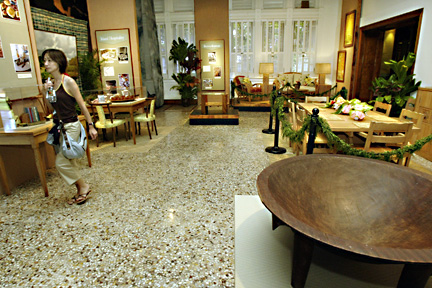
Rattan furniture translates to a tropical ambience in the "Hawaiian" home.
Island style
Typical ‘Hawaiian’ design elements
are not necessarily so, but they sure
fit together nicely
What's it mean to live in a home that is Hawaiian? Or to live in a home that is "Hawaiian"? The quotation marks matter. One is real, the other is set dressing. This is the sort of thought banging around inside one's skull while taking in the new Bishop Museum mini-exhibit called "Hawai'i -- A Sense of Place."
'Hawai'i -- A Sense of Place'On view: 9 a.m. to 5 p.m. daily through Oct. 23Place: Bishop Museum Vestibule Gallery next to Hawaii Hall Admission: $14.95; $11.95 for youth, kamaaina, seniors and military; members and children under 4 free Call: 847-3511
|
That "sense of place" concept is a key element infesting the minds of interior designers. (Not "decorators," mind you -- designers. It's a draw-the-line issue among some. It's all a matter of numbing degree to the rest of us, the folks whose wives have to check our clothes in the morning and for whom interior design means maximizing storage space.)
What it means, pretty much, is that the interior space all hangs together both thematically and texturally. A "Hawaii" sense of place doesn't necessarily mean a grass hut, lava-rock walls and sandy floor -- no, it takes in all the disparate cultural and ethnic influences that have flooded into the islands, and smooshes them around on a color palette that suggests natural textures and sunlight bouncing through leaves.
Take bamboo and anthuriums. Neither are native to the islands, and yet, Hawaiian interior design is hobbled -- crippled! taken down! -- without them. Anthuriums hail from the southeast of South America, and samples were hauled to England in the 1880s, where they were discovered in the Royal Hothouse by Samuel Mills Damon and transplanted to his Oahu estate in 1889. Hawaii gardeners went nuts for the "little boy" flowers, and soon they were everywhere, probably crowding out native species.
The same goes for bamboo, which came a little later but, unlike anthuriums, is actually useful.
The two plants became indivisibly welded to local culture and crafts. What this means in interior design is that what we think "Hawaii" is, is actually just what we think it is. It's a conception, not a reality. But if enough believe in the conception, then it becomes a reality. It's all rather down-the-rabbit-hole.

Several koa tea cups and saucers dress a dining room setting.
Here's a whole raft of items indelibly linked to Hawaiian styles -- the monkeypod bowl, carved in various lovely shapes and serving styles. The faintly oil-moist wood takes forever to dry out and crack, which makes it ideal for shelf knickknacks. But Hawaiian? Monkeypod trees weren't imported until the 1840s, and Hawaiians used their bowls. Putting them on a shelf to stare at is a Victorian conceit.
Alas, the exhibit is short on background. One whole section is devoted to the punee, the combo sofa-and-bed that is a favorite resting place in old-style homes, provided there's enough space. Several examples are shown, each of which makes you want to stretch out on them. But I can't tell from the limited signage whether the punee is a Hawaiian furniture item that has evolved or an imported concept from abroad that was Hawaiianized. A comfortable place to stretch out at midday, though -- good idea, whoever had it.
Other mini-departments in the exhibit include "Collectibles" (ranging from little wood ukuleles to kitschy plastic hula gals to mailed coconuts), the "Bark Cloth Craze" (again, not explained, but apparently a wedding of kapa cloth and screen-printing), "Retro-Rattan" (bamboo again) and "On the Lanai" (in which interior design is made to go outside).
The overall effect is one of florals and leafals and Art Deco geometries, all in tasteful balance.
The balance is the key. Where is the tipping point between tasty and tacky? You'll have to wait for the book.

A tourist from Japan strolls through the "Hawaii-A Sense of Place" exhibit at Bishop Museum.


Tropical prints and bamboo form a cohesive island interior in the exhibit "Hawaii -- A Sense of Place " at the Bishop Museum.
E-mail to Features Desk
[News] [Business] [Features] [Sports] [Editorial] [Do It Electric!]
[Classified Ads] [Search] [Subscribe] [Info] [Letter to Editor]
[Feedback]
